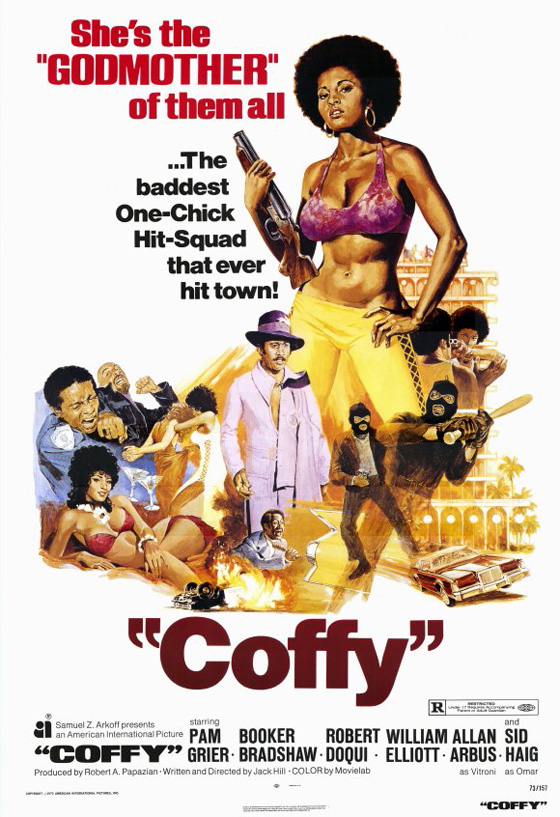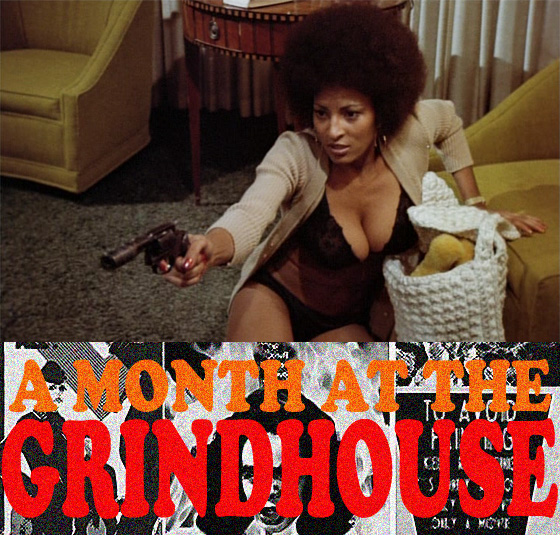
Coffy (1973) was just supposed to be an American International Pictures quickie rushed to production to beat to the finish line the bigger budgeted Warner Bros. film Cleopatra Jones (1973). Nothing more. AIP executive Larry Gordon (who originally had the rights to Cleopatra Jones before losing them to Warners) had little confidence in the film’s director, Jack Hill, and on the commentary track for Coffy, Hill recounts many instances of studio second-guessing, to the point of being pushed out of the editor’s room so that he didn’t see the finished product until its premiere. But Hill – who had directed one of the most original horror films of the 60’s, Spider Baby (1968) – knew what he was doing, and was confident that his secret weapon was his star. He was so enamored by Pam Grier’s talents that he not only gave her a significant role (as “Grear”) in their first film together, The Big Doll House (1971), but let her sing the theme song (“Long Time Woman,” later used by Tarantino in Jackie Brown). Coffy would be their third collaboration, their first shot somewhere other than the Philippines, and the one that made Pam Grier an icon for both the feminist and the Black Power movements. Call her the n-word and you pay the price – violently. The film sports a sublime funk theme song by Roy “Don’t Stop the Feeling” Ayers, who was given an Isaac Hayes-like carte blanche to supervise the film’s score: “Coffy is the color of her skin,” Ayers purrs, underlining the inspiration for the film’s title, a quote Hill took from a black actress who had once auditioned for him. The film is all black-is-beautiful but it also seethes: against drug-pushers on the street (shotgun to the head), against racists (pistol hidden in a teddy bear), against a black politician who not only sold out his beliefs but cheated on Coffy with a white woman (shotgun to the crotch). Coffy did what it was supposed to – beat the Warners film to theaters by a month, and became a high-grossing sleeper hit – but it also did something no one could have predicted: it seared itself into the public consciousness.
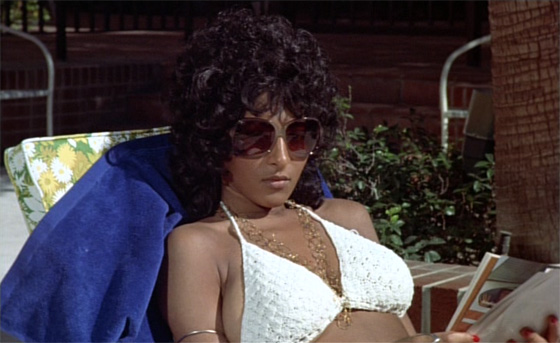
Pam Grier as Coffy, going undercover to infiltrate a criminal underworld.
Grier has said she was playing her mother, Gwendolyn Samuels, who, like Coffy, was a socially conscious nurse who used her talents to help those in need in her blighted neighborhood. What her mother didn’t do was turn vigilante, something Coffy offers in the kind of wonderful wish-fulfillment that exploitation movies can provide. In the opening scenes, Coffy seems to be a drug-sedated “piece of tail” on the platter to be served up to a drug-dealer. Then she whips out the shotgun and asks him to remember what happened to her sister, one of the dealer’s many casualties. Hill shows the back of the pusher’s head as the buckshot blows a hole through it. After this, she shoves a needle full of heroin into the dead man’s lackey to deliver a dose that could kill him: “Maybe it will or maybe it won’t, but if it do you’re gonna fly through the Pearly Gates with the biggest fucking smile St. Peter ever seen!” Early scenes show Coffy at work in the hospital, talking with her friend, an idealistic cop (William Elliott, Night of the Lepus), or in bed with her lover Howard Brunswick (Booker Bradshaw, Skullduggery), who’s running for Congress, but increasingly she’s drawn into a world of violence, as she decides to go undercover as a Jamaican hustler to bust up a gang led by a sadistic drug lord named Vitroni (Allan Arbus, ex-husband of photographer Diane Arbus). To secure her reputation, she sleeps with a pimp named King George (a fantastic Robert DoQui, later of Robocop), which incurs the wrath of his jealous hookers. In what is surely the greatest cat-fight in screen history, Coffy takes on each of the girls at King George’s party, throwing them through tables of food, dunking them in guacamole and ripping off their tops. When her chief rival (Linda Haynes, Rolling Thunder) seizes hold of Coffy’s head, she quickly lets go with blood running between her fingers and down her wrists: Coffy has hidden razor blades in her afro.
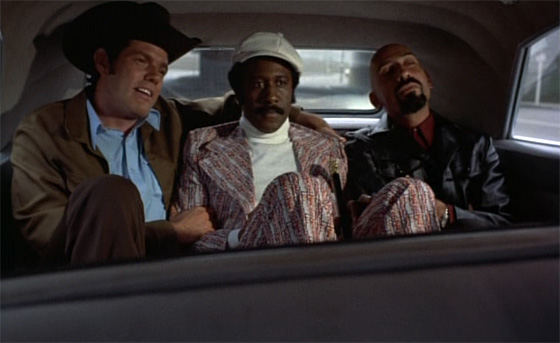
King George (Robert DoQui) is taken for a ride by two of his boss's henchmen (Ray Young and Sid Haig).
The cat-fight scene is typical Jack Hill: outrageous, commercially-minded exploitation (every few seconds, more nudity arrives) that’s also hilarious, and geared to evoke a burst of audience applause when it’s all over. Grier loved this trashy playground and took none of it seriously. Regarding this fight scene, she told the Film Society of Lincoln Center earlier this year: “When I had a malfunction with a spaghetti strap, and it broke, and it showed my nipple, it changed the whole evolution of film. Just one little nipple. But I was into my craft and I wasn’t going to fix my strap while I was trying to kill someone… I had to drink after this, after Anne Hathaway had to apologize for her nipples showing through the dress at [the] red carpet. Are you kidding me, are we six years old? Why should she apologize for her nipples? I thought I had opened a door for her and everybody!” Jack Hill’s own DeNiro, Sid Haig (Spider Baby, The Big Bird Cage), is a standout as Omar, an Armenian bodyguard for Vitroni, managing to make the character simultaneously charismatic, funny (what he wears while sunbathing is particularly memorable), and loathsome. He dominates a particularly chilling scene in which he delivers some nasty payback to King George. Like any good revenge picture, Coffy sets up characters you can really despise so you relish their bloody comeuppance when it finally arrives; and Haig gets a fitting death. As for Vitroni, after (literally) spitting some hateful racist dialogue at Coffy, he thwarts her assassination attempt and we’re robbed of early satisfaction. This only makes his final, pathetic end – in Roy Rogers’ swimming pool, no less – all the sweeter.
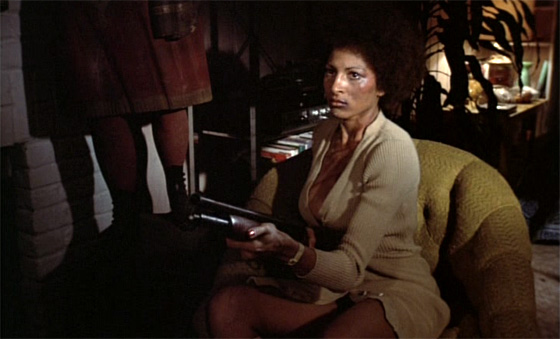
Coffy sees it through.
As in so many political thrillers of the 70’s, following the conspiracy trail finally leads back home, and Coffy learns that her politician boyfriend has been corrupted by Vitroni’s drug money. (Not only this, but he casually signs off on her murder.) Her final confrontation with Brunswick is a revenge-movie classic, in which Coffy, confronted with the monster her man has become, breaks down into tears, before finding good cause – in the form of a blonde, topless mistress – to follow through on her mission. Grier is fantastic in this scene, presenting her character as vulnerable and human (and woman); before ultimately proving to be the toughest and strongest of everyone – the last one standing. The final shot, while the credits roll, is Coffy walking down a beach at night, while the lyrics of Ayers’ “Shining Symbol” spell it all out for us, in case we somehow missed the point: “Revenge is a virtue/you stood up like you should/standing up strong/like we all wish we could/you’re a shining symbol, a shining symbol, a shining symbol/of Black Pride.”
